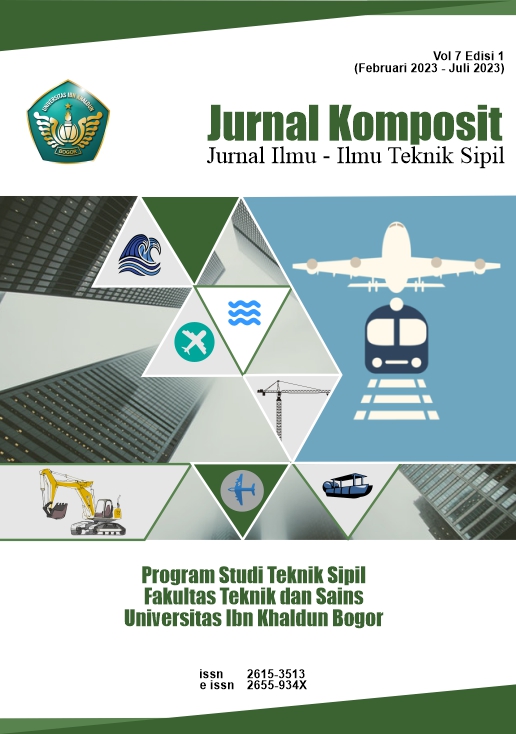Transformasi Stadion Olah Raga KONI di Kawasan Perdagangan Kota Jambi
DOI:
https://doi.org/10.32832/komposit.v7i1.11104Kata Kunci:
transformasi fungsi, stadion olah raga KONI, kawasan perdagangan, kota JambiAbstrak
Kota berkembang dari suatu kawasan inti yang meluas ke sekitarnya. Kawasan awal mula ini yang kemudian menjelma menjadi pusat kota. Pada awalnya banyak kota direncanakan dalam skala kecil, sehingga pada kawasan tersebut dipersiapkan fasilitas-fasilitas perkotaan yang lengkap, termasuk fasilitas sosial dan rekreasi yang di antaranya merupakan fasilitas olah raga. Ketika suatu kota berkembang pesat dan terjadi perubahan peruntukan, bisa terjadi suatu fasilitas yang dalam hal ini fasilitas olah raga berupa stadion menjadi berada di tengah-tengah kawasan perdagangan yang berkembang pesat. Dalam situasi demikian, maka muncul permasalahan tentang fungsi stadion tersebut. Secara ekonomi muncul tuntutan agar aset stadion dialihfungsikan menjadi sarana yang memiliki nilai ekonomi selaras dengan peningkatan nilai lahan dan properti di sekitarnya. Kasus tersebut juga terjadi pada Stadion Koni di Kota Jambi. Dimana di samping permasalahan terkait keberadaannya di kawasan strategis ekonomi, juga dengan masih dibutuhkannya stadion ini oleh warga, selain untuk fungsi olah raga, juga sebagai sarana aktivitas sosial. Hal ini mengingat keterbatasan ruang publik di Kota Jambi. Ditambah lagi dengan kondisi penurunan vitalitas kawasan yang diperlihatkan dengan banyaknya underutilized propertiy di sekitar kawasan. Hal lain adalah masih ada area permukiman pada kawasan dan di lingkungan sekitarnya. Bagaimana mempertemukan beragam tuntutan tersebut pada kawasan stadion yang keberadaannya bagi warga kota juga sudah melekat sebagai identitas kawasan. Dan bagaimana stadion tersebut bisa bertransformasi secara fungsi untuk memenuhi kebutuhan programatik yang baru dalam permasalahan kawasan yang ada. Untuk itu dilakukan suatu kajian deskriptif kualitatif dengan melihat morfologi kawasan saat ini dan potensi proyeksi pengembangan kawasan Stadion Koni tersebut di masa depan. Kajian literatur juga dilakukan untuk mendapatkan landasan teori yang bisa dipergunakan. Selain itu, juga dilakukan kajian preseden pada permasalahan yang serupa. Selanjutnya dari simpulan kajian di atas, dirumuskan suatu model desain arsitetur yang bisa memenuhi dan menjawab permasalahan yang ada. Dari penelitian yang dilakukan, ditemukan desain kawasan mixed use yang dapat memenuhi beragam tuntutan untuk menyelesaikan permasalahan kawasan. Selain itu, juga diusulkan suatu solusi terkait transformasi permukiman yang ada pada kawasan. Secara arsitektur dirancang untuk bisa menyelaraskan dengan nilai ekonomi lahan dengan desain bangunan vertikal namun memberikan gradasi skala yang memberi penghargaan pada skala kawasan hunian sekitar dan tentunya pada aspek sosial humanisme-nya. Secara fungsi arsitekturnya selaras dengan pendekatan mixed use kawasan bersifat terbuka dan mengakomodir tuntutan ragam programatik kebutuhan.
Referensi
Brandt, T., B., Diener, K. J. & Du, V. (1999). Commercial and Mixed-Use Development Code Handbook. 18.
Brown, L. J., Dixon, D. (2014). Urban Design for Urban Century : Shaping More Livable, Equitable and Recilient City (2nd ed.). John Wiley & Son.
Calthorpe, P. (1993). The Next American Metropolis: Ecology, Community, and The American Dream. Princeton Architectural Press.
Goodman, A. (2008). Residential Mixed-Use, Urban Infill Project: Encouraging Social Interaction Among Baby Boomers. Retrieved from http://purl.flvc.org/fsu/fd/FSU_migr_etd-4138
Lynch, K. (1960). The Image of the City. Cambridge: The M.I.T. Press.
Peraturan Daerah Kota Jambi (2013) No. 9 Tahun 2013 tentang Rencana Tata Ruang Wilayah Kota Jambi Tahun 2013-2033
PSUD. (2021). Urban Design: Indonesian Experience. Jakarta. Imaji.
Rossi, A. (1982). The Architecture of The City. Massachusetts, The MIT Press.
Shirvani, H. (1985). The Urban Design Process. Van Nostrand Reinhold. Co, New York.
Trancik, R. (1986). Finding Lost Space: Theories of Urban Design. In Landscape Journal (Vol. 7, Issue 1). Van Nostrand Reinhold. https://doi.org/10.3368/lj.7.1.80
Unduhan
Diterbitkan
Cara Mengutip
Terbitan
Bagian
Lisensi
Hak Cipta (c) 2023 Jurnal Komposit: Jurnal Ilmu-ilmu Teknik Sipil

Artikel ini berlisensiCreative Commons Attribution-ShareAlike 4.0 International License.
Authors who publish with this journal agree to the following terms (Penulis yang mengajukan publikasi artikel telah menyetujui hal berikut):
- Through this publication, the author agree to submit the copyright of article writing to Jurnal Komposit: Jurnal Ilmu-ilmu Teknik Sipil. This copyright submission takes the form of, but is not limited to: reproduction of the article and parts therein, including photographic reproductions; distribution of articles through printed and electronic documents; and translation of articles(Bahwa melalui publikasi ini, hak cipta penulisan artikel diserahkan kepada Jurnal Komposit: Jurnal Ilmu-ilmu Teknik Sipil. Penyerahan hak cipta ini berupa, namun tidak terbatas pada: perbanyakan artikel dan bagian di dalamnya, termasuk reproduksi fotografi; penyebarluasan artikel melalui dokumen cetak dan elektronik; serta penterjemahan artikel).
- The authors agree to the terms of the Copyright Notice, according to Creative Commons Attribution-NonCommercial-ShareAlike 4.0 International License., which will apply to this article if and when it is published by Jurnal Komposit: Jurnal Ilmu-ilmu Teknik Sipil. (Para penulis setuju dengan ketentuan Pemberitahuan Hak Cipta, sesuai dengan Lisensi Internasional Creative Commons Attribution-NonCommercial-ShareAlike 4.0., yang akan berlaku untuk artikel ini jika dan ketika diterbitkan oleh Jurnal Komposit: Jurnal Ilmu-ilmu Teknik Sipil).

This work is licensed under a Creative Commons Attribution-NonCommercial-ShareAlike 4.0 International License.



.png)










